Decorated warbonnet • Chirolophis decoratus
{Chiro = hand, lophis = crest; decoratus = ornamental}
Decorated warbonnets peek out from holes, revealing elaborately-branched cirri and dark eye stripes. Photos by Jenn Burt (left) and Wiebe Nijland.
Identification
The bushy cirri (projections) that adorn the long head of this prickleback are its main identifying feature. It also has cirri behind its head, on the first four spines of its dorsal fin. It is orange or brown with dark mottling and dark bars under its eyes and along its fins. Its body is elongated, with long low dorsal and anal fins, large pelvic fins, and a relatively small rounded tail fin. It gets to 42 cm long.
Habitat & Range
This prickleback lurks among seaweeds and hides in rock crevices and holes in large sponges at depths of 1.5 to 90 m. Its range extends from Kamchatka, Russia, the Bering Sea coastline of northern Alaska, and the Aleutian Islands south to northern California.
Similar Species
The mosshead warbonnet (Chirolophis nugator) has less extensively-branched cirri on its head and first dorsal spines, and evenly-spaced eye-spots along its dorsal fin. The matcheek warbonnet (C. tarsodes) is similar in appearance to the decorated warbonnet but is relatively rare in the Pacific Northwest and has not been recorded further south than northern British Columbia.
The bushy cirri (projections) that adorn the long head of this prickleback are its main identifying feature. It also has cirri behind its head, on the first four spines of its dorsal fin. It is orange or brown with dark mottling and dark bars under its eyes and along its fins. Its body is elongated, with long low dorsal and anal fins, large pelvic fins, and a relatively small rounded tail fin. It gets to 42 cm long.
Habitat & Range
This prickleback lurks among seaweeds and hides in rock crevices and holes in large sponges at depths of 1.5 to 90 m. Its range extends from Kamchatka, Russia, the Bering Sea coastline of northern Alaska, and the Aleutian Islands south to northern California.
Similar Species
The mosshead warbonnet (Chirolophis nugator) has less extensively-branched cirri on its head and first dorsal spines, and evenly-spaced eye-spots along its dorsal fin. The matcheek warbonnet (C. tarsodes) is similar in appearance to the decorated warbonnet but is relatively rare in the Pacific Northwest and has not been recorded further south than northern British Columbia.
References
Froese, R. and Capuli, E. E. Chirolophis decoratus (Jordan & Snyder, 1902) Decorated warbonnet. FishBase. Accessed 23/02/2015.
Harbo, R. M. (2011). Whelks to whales: Coastal marine life of the Pacific Northwest [revised]. Madeira Park, BC: Harbour Publishing. P. 224.
Lamb, A. and Edgell, P. Coastal Fishes of the Pacific Northwest. Revised. (2010). Madeira Park, BC: Harbour Publishing. P. 124.
Lamb, A., and Hanby, B. (2005). Marine Life of the Pacific Northwest [electronic version]. Madeira Park, BC: Harbour Publishing.
Authors and editors of page
Kelly Fretwell and Brian Starzomski (2015).
Froese, R. and Capuli, E. E. Chirolophis decoratus (Jordan & Snyder, 1902) Decorated warbonnet. FishBase. Accessed 23/02/2015.
Harbo, R. M. (2011). Whelks to whales: Coastal marine life of the Pacific Northwest [revised]. Madeira Park, BC: Harbour Publishing. P. 224.
Lamb, A. and Edgell, P. Coastal Fishes of the Pacific Northwest. Revised. (2010). Madeira Park, BC: Harbour Publishing. P. 124.
Lamb, A., and Hanby, B. (2005). Marine Life of the Pacific Northwest [electronic version]. Madeira Park, BC: Harbour Publishing.
Authors and editors of page
Kelly Fretwell and Brian Starzomski (2015).





